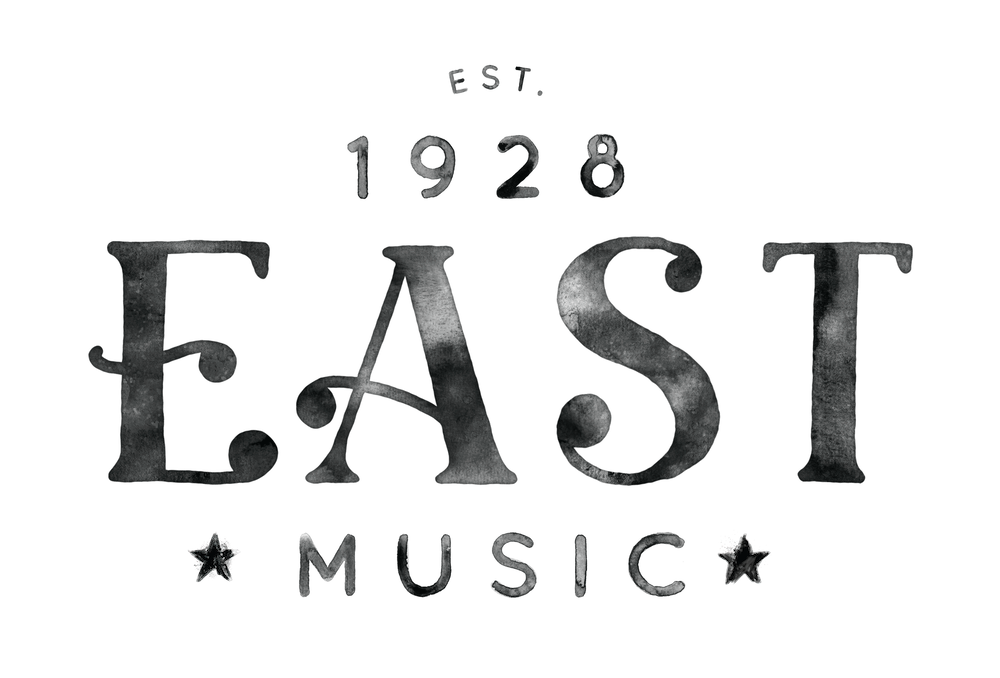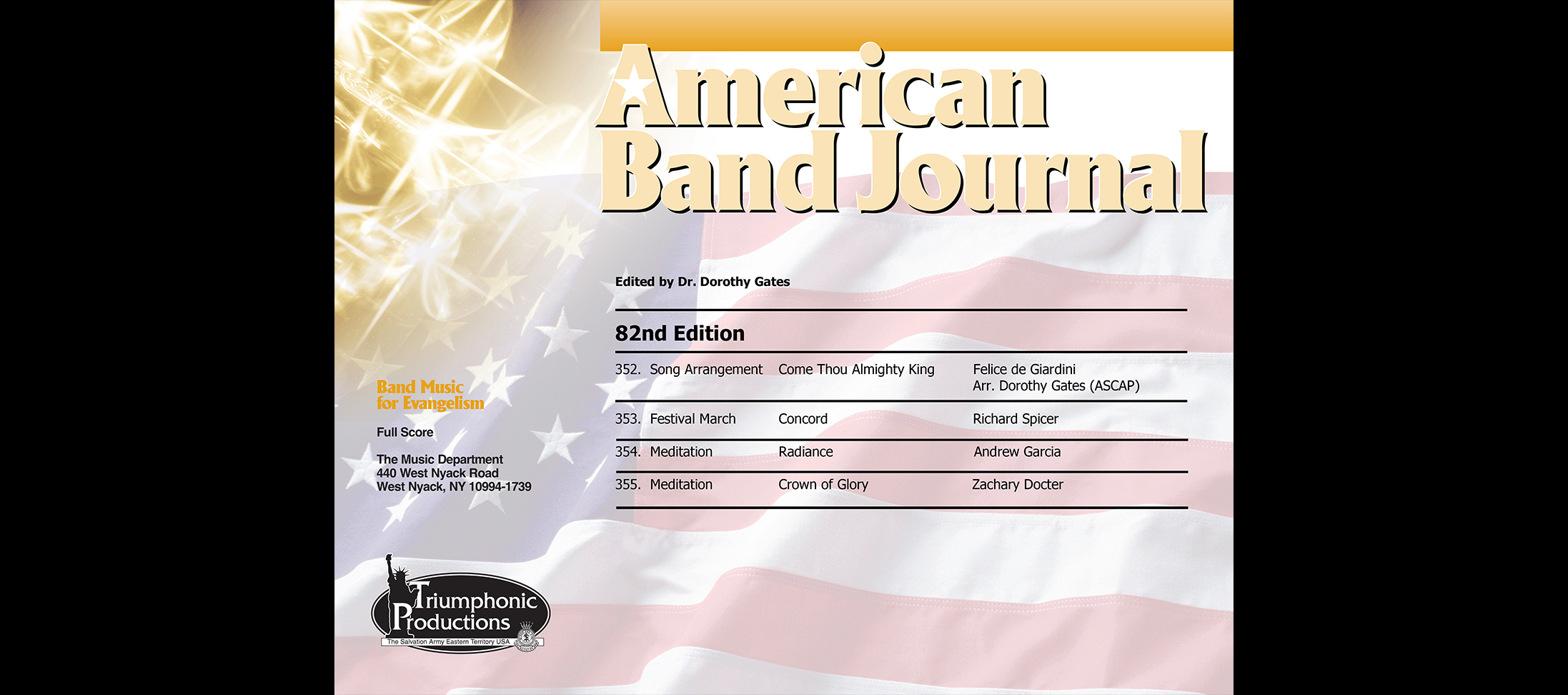AMERICAN BAND JOURNAL 82nd EDITION
No. 352—355
Edited by Dr. Dorothy Gates
PREFACE
We are once again very excited to publish the latest edition of the American Band Journal with another fabulous lineup of music and composers. Kicking off this edition is our composer-in-residence and editor, Dr. Dorothy Gates with her arrangement of “Come Thou Almighty King”. This excellent new work can be used as both a standalone selection or for congregational singing at any worship service. Joining Dorothy in this edition are three composers being published for the first time in the American Band Journal. First in this trio is an older march from the pen of Richard Spicer, “Concord” that features the song. “Give Thanks”. What a privilege it is to publish this piece over twenty years after his passing. Also making their ABJ debut are the next two composers, Andrew Garcia and Zachary Dochter. Andrew has crafted a fine piece, “Radiance” which is based around the tune, “In my life, Lord”. This piece was recently recorded by the NYSB on its latest CD, Endless Power, and is a welcome addition to any band’s repertoire. Zachary also adds his piece, “Crown of Glory” based around the tune, “St. Magnus”. This thought provoking and moving piece will be invaluable for worship in any setting.
This edition of the American Band Journal has a wonderful mix of pieces and we are certain it will be received well by both the players and listeners. As you play and perform this music, we pray that it will be used to honor and glorify God and will connect us to Him in the way that only music can.
Derek W. Lance
Territorial Music Secretary
Available for purchase HERE.
INSTRUMENTATION
Though nine instrumentalists may adequately present this music, it is designed to work equally well or better with full concert band, orchestra or brass band instrumentation. For nine brass instrumentalists, two cornetists should be assigned to the first cornet part because of the frequent use of divisi, with one second cornet, two horns, two trombones, one euphonium, and one tuba completing the minimum group. The optional parts – soprano cornet, flugel horn, baritone, bass trombone and percussion – are all included in the score. The music is complete without these parts, but their use will greatly enhance the performance as long as the fundamental parts are covered. Download complimentary transposed parts in F and C (TC/BC) online via: www.music.saconnects.org
PROGRAM NOTES AND NOTES TO THE CONDUCTOR
No. 352 SONG ARRANGEMENT – COME THOU ALMIGHTY KING
ARR. DOROTHY GATES (ASCAP)
Program Note:
This piece was written at the request of Commissioners Barry and Sue Swanson for their Retirement service in June 2016. The tune is “Moscow” and can be used as a congregational song accompaniment as all four verses of the tune are featured. With a fanfare opening and brilliant conclusion, it can also be used as a program opener.
Note to the Conductor:
The Allegro Maestoso tempo should be strictly dictated so that the fanfare opening is brilliant, and rhythms carefully played not to rush the 16th notes in all sections.
Note that the 1st verse is mezzo forte, the 2nd and 3rd verses mezzo piano. At m. 73 you come back to the original fanfare which leads to the triumphant 4th verse and
brilliant ending.
No. 353 FESTIVAL MARCH – CONCORD
RICHARD SPICER
Program Note:
This march was written in the early 1990s for the band in the California city where the composer served as bandmaster. It successfully weds the tunes “Sing and Make Music” and “Give Thanks” into an enjoyable and lively march. Unfortunately, the composer died suddenly and unexpectedly at the age of 51 in 1996. This gifted musician was well-known as an excellent conductor, composer and pianist. He has left behind a legacy of unpublished music.
Note to the Conductor:
Be sure that the march begins briskly and with drive at the indicated tempo marking. Observe the dynamic markings throughout the march and note the difference in the dynamic marking the second time through beginning with m. 8. Note that the first tune presented at m. 22, is only marked at a ‘mf ‘ dynamic level. The cornet section accompaniment at m. 30 will need to be carefully rehearsed. Maintain the balance of dynamics at m. 61 with the “Give Thanks” melody being slightly louder than the underneath staccato quarter notes. Control the crescendo beginning at m. 88 and be sure that the dynamic level reaches only ‘ f ‘ at m. 96. Again, the cornet parts along with the euphonium part will need to be carefully rehearsed at m. 96. Save the strongest playing until m. 112 but always keep the dynamics under control until the finish and let the melody predominate.
No. 354 MEDITATION – RADIANCE
ANDREW GARCIA
Program Note:
The title of this selection comes from a reference to Matthew 5:16 where Jesus says: ‘Let your light shine before others, that they may see your good deeds and glorify your father in heaven.’ What a powerful message this carries, declaring our life to be a beacon of holiness to the world around us. Ultimately this verse led to the creation of this arrangement. It is a setting of the simple lyrics ‘In my life, Lord, be glorified,’ and musically sets out to depict the transformation from a quiet statement, fraught with uncertainty and hesitation, into a whole-hearted declaration of surrender at the conclusion. Also referenced throughout is the equally simple, equally powerful words ‘In me, in me, Holy Spirit, dwell in me.’ It is hoped that the hearer finds in this selection an earnest invitation for the Holy Spirit to be the light that radiates God’s glory wherever we go.
Note to the Conductor:
The beginning and ending of this piece are both meant to feel out of time, almost existing outside of a time signature. While this allows for some flexibility, in a rubato approach, it is important to establish a consistent tempo and periodic phrasing by m.9. Allow the introduction of the tune to be an arrival point. Throughout m. 17, it is important to be able to hear the solo passages. This may require the soloists to play prominently, but mostly entreats the accompaniment to be sensitive to the soloist. Try to achieve a good balance between the two tunes before m. 57.
No. 355 MEDITATION – CROWN OF GLORY
ZACHARY DOCTER
Program Note:
This piece is a short meditative treatment of the tune “St. Magnus.” The tune first emerges out of a bell tone effect and it continues to appear through several different iterations. Some liberties have been taken with the traditional harmonic structure of the tune. However, toward the end of the piece, the tune reemerges in its traditional form creating a powerful effect.
Note to the Conductor:
The piece is generally straightforward although there are certain things to keep in mind. The dynamics should be observed as written. The accents in the bell tone section of m. 9 should be emphasized so the effect can be heard. In m. 2-3 and again in m. 64-65, it is important for the 1st cornet soloist to play the repeated notes very legato and not detached. Throughout the central section of the piece, triplets appear in the horn, baritone, euphonium, and cornet parts. These should be rehearsed to ensure that they can be played together and in time. They are not too fast, but they can be problematic if not practiced.
ADAPTING THE AMERICAN BAND JOURNAL FOR CONCERT BAND OR ORCHESTRA
The following will be a helpful guide to musical directors who use the ABJ with their
concert band or orchestra. Contact the Eastern Territorial Music Department via
telephone at (845) 620-7444 or online at www.music.saconnects.org for a free set
of transposed parts.
Instrument
Flute
Oboe
English Horn
Bassoon
Eb Soprano Clarinet
Bb Clarinet 1
Bb Clarinet 2,3
Eb Alto Clarinet
Bb Bass Clarinet
Eb Contra Alto Clarinet
Bb Contra Bass Clarinet
Eb Alto Saxophone 1
Eb Alto Saxophone 2
Bb Tenor Saxophone
Eb Baritone Saxophone
Violin
Viola
Cello
String Bass
Keyboard
ABJ Part to Play
C Instrument (upper octaves)
C Instrument (lower octaves)
F Horn 1 or 2
Baritone, Euphonium or Tuba B.C.
Eb Soprano Cornet
Bb Cornet 1
Bb Cornet 2
Eb Horn 2
Bb Bass
Eb Bass
Bb Bass
Eb Horn 1
Eb Horn 2
Bb Baritone
Eb Bass
C Instrument (divisi)
Not provided
Baritone or Euphonium B.C.
Bass Tuba B.C.
C Instrument (in octaves)

